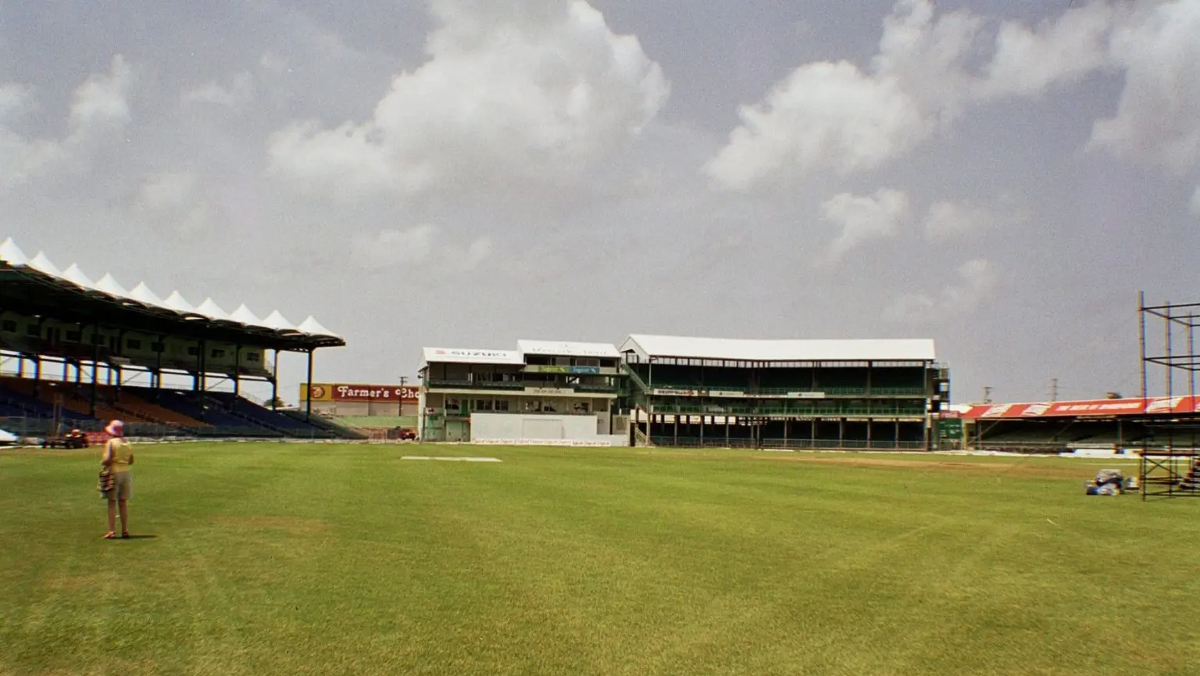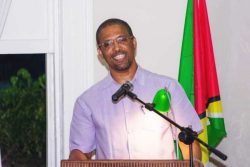In this week’s edition of In Search of West Indies Cricket, Roger Seymour recounts a visit to the Kensington Oval, Barbados during the post-match celebrations of the 1997 Third Test match between the West Indies and India, addressed in last week’s “An Easter tale”.
Easter Monday, 31st March, 1997 — A constellation of kites danced in the wind, against a backdrop of warm sunshine and a bright blue sky, as we began to leave the Garrison Savannah. I glanced one last time in the direction of the gigantic kite. It has plummeted to earth for the umpteenth time and the crew of eight, several of whom are wearing gloves, are fussing over it once more.
“It’s the tail. I keep telling you all, the tail too heavy. We have to cut this inch rope by two feet at least…,” one suggests at the top of his voice. His yelling fades as we walk away. I’m no longer concerned with the kite’s buoyancy. The fall of wickets in India’s second innings had been uncannily synchronised with the descents of the monster kite, but the match was over.
In the rental car, I switch on the radio and listen to the summary of the Test match. Two West Indian commentators are reviewing the game and the highlights are being relived via splices of commentary.
As I navigate the twisting roads of St Michael’s Parish, the review of the third day’s play commences. The first commentator is full of praise for Brian Lara’s captaincy in the absence of the injured Courtney Walsh, noting the shrewd manipulation of the resources at hand, the constant shifting of the field from offensive to defensive positioning, and the rotation of the bowlers. He notes that Lara entrusted the opening spell to the less experienced but in-form Franklyn Rose over the spearhead of the attack, Curtly Ambrose, who, he quickly reminds us, delivered 15 no-balls in the first inning, and had bowled the opening over the previous afternoon. The acting skipper then opted for Ian Bishop to continue from the northern end, where he had delivered half an over on Sunday afternoon, before bad light stopped play after 1.3 overs. Mervyn Dillion, the fourth member of the quartet, playing in only his second Test, is never called upon to bowl.
Rose lived up to the challenge thrust upon his young shoulders, and in a hostile spell of nine overs, the second commentator observes, took the wind out of India’s sails. At the start of the day, they had appeared destined for their second overseas Test victory in ten years.
The spliced tapes recount the falling of the Indian batsmen, “…Oh how do you play that? That’s what I say about this pitch, it’s a killer…” Off of Rose’s ninth delivery, which rises sharply, Navjot Sidhu can only paw at it, popping it up for the easiest of catches for Stuart Williams at third slip. India three for one wicket. Rahul Dravid, in the number three slot, scratches for 36 minutes, before, “…that’s beautifully bowled by Rose, and Dravid edges it to Courtney Browne, looks like it came off the glove…” India 16 for two. At this stage it looked like everything hinged on Sachin Tendulkar, India’s 23-year-old captain.
Lara, looking to keep the pressure on, reverts to Ambrose after two overs by Bishop, but it’s Rose, once again, who undermines India’s second innings. “… And he’s bowled him. VVS Laxman playing all around it, that one was pitched up and went through his defence…” The intense roar of the crowd can be heard, along with rhythmic drumming and the shrill cry of a trumpet. India, 32 for three. Without further addition to the score, Lara returns the compliment his counterpart paid him in the West Indies first innings. “…Edged and taken by Lara, the sole slip fielder, Bishop has done it, this is a big blow for India, Tendulkar gone, the West Indian crowd is ecstatic. Not an easy catch, he had to move forward, the ball took the outside edge as Tendulkar attempted a front foot drive, India in deep trouble…”
India’s hopes of victory now rested on Saurav Ganguly and the former Indian captain Mohammed Azharuddin. Lara went for the jugular, and from here on it was Ambrose and Bishop. Ambrose found his rhythm and delivered the final psychological knockout punches. “…Bowled him, Ganguly cleaned bowled, Ambrose finding the gap between bat and pad and removing the off-stump, India, 45 for five.” Soon afterwards, “…and that kept very, very low, Ambrose bowled Azharuddin, who stood for a second in total disbelief and looked at the shattered stumps. What can any batsman do with that delivery? All the while the ball has been coming at your face, now it scoots around your ankles. Like Ganguly, Ahzaruddin completely foxed by the pitch. India, 51 for six.”
Just before lunch, the die was cast. “…Bishop’s in, it’s in the air, Holder is waiting for it, he takes the catch, Kumble is out, spooning it high in the air into the safe hands of square-leg. It’s that kind of pitch, ball not quite coming on, ball bouncing, ball keeping low, not too many batmen would have flourished on this pitch …”. India 57 for seven. Ten minutes into the second session Bishop removed wicket-keeper Nayan Mongia’s off-stump as the batsman shouldered arms thinking it was wide. “…India in dire straits, 66 for eight.” Dodda Ganesh and Abey Kuruvilla, delay West Indian celebrations by occupying the wicket for another 25 minutes, adding 14 runs, then: “…It’s straight to Holder at short-mid wicket, and that will be out, Kuruvilla pops an Ambrose delivery straight to the fielder.” One run later, the West Indies had secured an unlikely victory by 38 runs.
India’s total of 81, their lowest ever in a Test in the Caribbean, included 15 extras, 11 of which were no-balls; a bit of an improvement on the 30 conceded in the first innings. The last wicket partnership of 33, between Ambrose and Dillion in the West Indies’ second knock, turned out to be the difference in the match. One commentator referenced former England opening batsman Geoffrey Boycott, one of the television broadcasters, who had expressed utter disgust at India’s casual approach when Ambrose and Dillion, in particular, were swotting the Indian bowlers around on Sunday. India had paid the ultimate price. Shiv Chanderpaul, whose undefeated maiden test century (137) held the West Indies first innings together was voted Man of the Match.
I switch off the radio as we arrive at our hosts. My friends head off to pack for our flight later in the evening and I depart for Kensington Oval. On the way, a phrase describing one of the dismissals in the summary, keeps echoing: “…Not too many batsmen would have flourished on this pitch I tell you…” It’s the voice of an Indian commentator. He has piqued my interest. I arrived at Kensington in ‘labba’ time. The game has been over for about an hour and the gates are open. Most of the estimated 4,000 spectators are still at the ground. Everywhere I turn there are people milling around. There’s quite a large gathering in front of the Pickwick Pavilion, although the presentations have been completed. In the centre of the ground, 20 to 30 people appear to be wandering aimlessly. I discover that they are actually scrutinising the source of my curiosity.
It’s the only marked pitch in sight and I can see the holes where the stumps once were, yet I quite dumbly enquire of one of the ‘inspection’ team whether this was the wicket that the Test was played on. As I receive a nod in confirmation, the sound of a familiar voice pierces the melee. “Can you bloody believe this? They played a Test match on this bloody thing? I can’t recall practising on anything this bad. Bloody goats wouldn’t even graze on this,” the well-attired Englishman is remarking to another member of the Trans World International television broadcast crew. It’s Boycott. The former world record holder for the most runs in Test cricket and eighth on the list of the most runs scored in first-class cricket has seen and batted upon hundreds of pitches, and certainly knows what he is speaking of. Known for his brash and controversial comments, Boycott is invariably outspoken and calls it as he sees it. However, Boycott’s vast cricketing experience was not required for examining what lay at our feet. At both ends, and in other parts of the pitch there were large splotches of earth that did not match the colour of the rest of it. To the untrained eye, it appeared that topsoil, or earth from another source had been laid on various parts of the pitch, thus giving it the somewhat unusual appearance of a patchwork quilt.
The evidence of the disaster is there for all to see. Who was responsible for this? The excuse will probably be that the two captains asked for a livelier wicket than what the first two Tests were played on, at Sabina Park, and Queen’s Park Oval, respectively. Well they certainly got more than they asked for, it appears. Only three batsmen had innings over 50, and in India’s second innings, only Laxman made it to double figures. Shiv’s and Tendulkar’s innings should be classified as rare works of art sculpted out of the hardest stone.
There is a crowd mingling in front of the pavilion. The fast-bowling demolition crew of Ambrose, Bishop, Rose and Walsh are sitting on a bench at the top of the stairs, smiling and laughing as they chat among themselves. Occasionally, they give a wave as the crowd chants each of their names in turn. There is euphoria everywhere I turn. Everyone is walking on air.
There is another group off to one side. Everyone appears to be armed with a beer bottle and moving non-stop. There are several Trinidad and Tobago flags being waved. It’s a carnival fete. It’s the Trini Posse bedecked in bright yellow t-shirts, and bearing signs which read, ‘The Prince of Port-of-Spain’ and ‘Trini Posse’. Overflowing with mirth, they don’t need much encouragement to relay their story. They are a bunch of friends who love West Indies cricket and they travel all over the Caribbean to support the team. The group started five years ago with a trip to the South Africa Test match also at Kensington and they claimed to be the only people in attendance on the last day. A voice from the rear shouts, “I predicted it last night!!! 50 for six!! No one believed me!!! Ask them, I predicted it!!!” The young man is shirtless and is having the time of his life. His team has won and life is good. These are hard core West Indies cricket fans. I have to escape their overtures to join the celebrations which seem destined to continue through the night.
My final port of call is the souvenir shop. Bobby Goodman, the manager, has his hands full with customers. Eventually, he gets around to me, and we exchange pleasantries, and I confess my absence on the last day’s play. As he gathers my order I enquire about the state of the pitch. He just smiles broadly, as someone else in the shop interjects, “Don’t expect to read anything ‘bout that in the papers here tomorrow. No Bajan ain’t gon’ critcise another Bajan. Youngster you got to understand de politics here.”
I have a plane to catch.
This article is dedicated to the memory of the six members of the Trini Posse who lost their lives in a tragic accident following the Third One Day International between the West Indies and India on the 30th April, 1997 in St Vincent. Reports said their light aircraft, a twin-engine Beechwood Baron, went down 35 seconds after take-off at 8:04 pm from the E T Joshua Airport at Arnos Vale.









